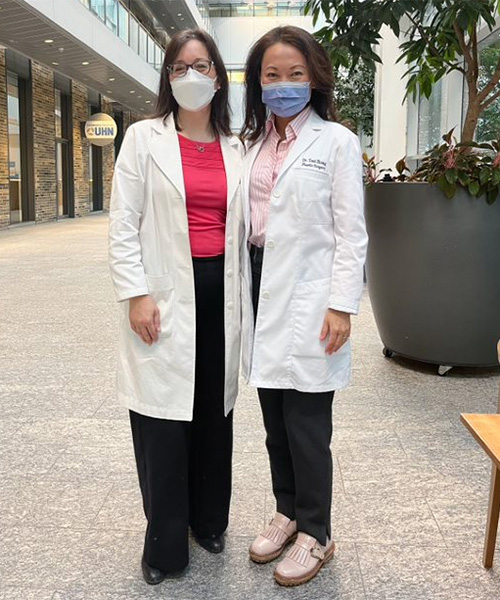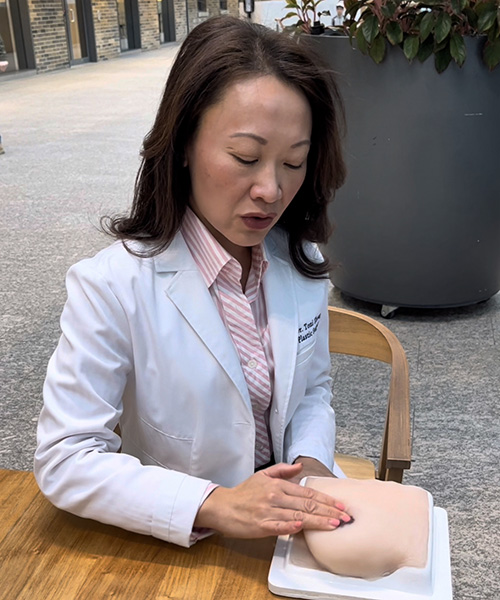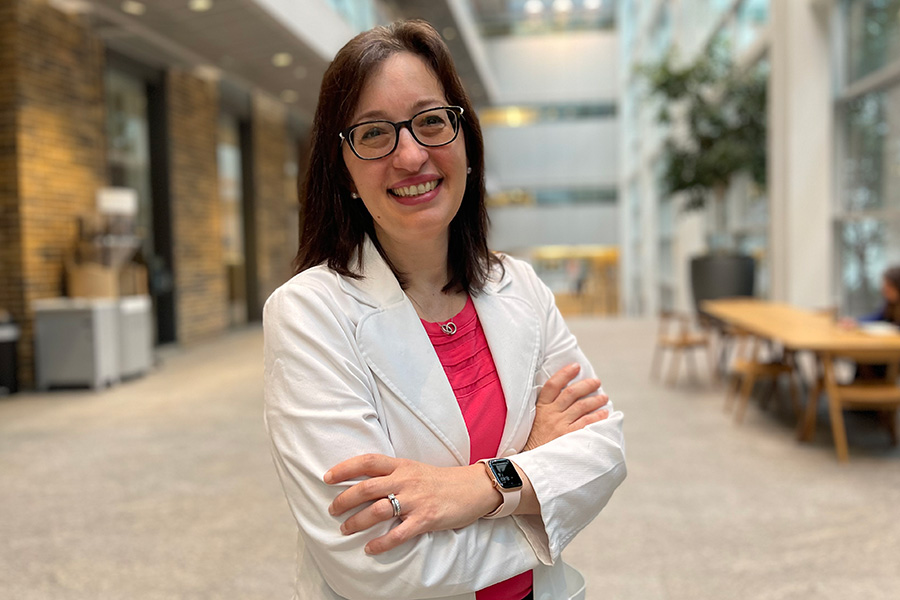
In Canada, one in eight women will be diagnosed with breast cancer in their lifetime. Every day, 15 women will die of breast cancer.
But, there is hope. Breast cancer survival rates have improved dramatically in the past three decades, with more than 90 per cent of women now surviving cancer (though survival rates vary depending on the stage and whether it has spread).
Dr. Tulin Cil, a staff surgeon and surgical oncologist at the Princess Margaret Cancer Centre, and the Gattuso Chair in Breast Surgical Oncology, and Dr. Toni Zhong, UHN Clinical and Research Director of the UHN Breast Reconstruction Program and Belinda Stronach Chair in Breast Cancer Reconstructive Surgery, explain why, and highlight how early detection and more precise treatments have improved outcomes.
Dr. Zhong also introduces her special guest, Marg, a silicon model of a breast named for the Princess Margaret Cancer Centre, to help show women how to do a self-exam.
Q: What was the impact of COVID-19 on breast cancer screening?
Dr. Zhong: The Ontario Breast Cancer Screening Program did stop screening almost entirely for first few months at the beginning of the COVID pandemic, which created a backlog. There are over 400,000 breast screening tests in that backlog. The good news is the program is working on diminishing them but we do encourage women to come in and get their screening when it is time.
Q: The Ontario Medical Association says screenings have returned to normal levels; but what is the impact of the temporary decrease in testing on breast cancer?
Dr. Cil: The benefit of screening is it allows us to catch breast cancer when it is early and too small to even feel. We do worry that decreased screening, even for a short time, may lead to patients coming in later with higher stage disease (larger tumours, or spread to lymph nodes). Thankfully, we have resumed breast screening to pre-pandemic volumes and are making up the backlog of tests that were missed.
The Gattuso Rapid Diagnostic Centre at the Princess Margaret has stayed open during the pandemic. The centre is a one-stop shop for breast cancer screening, diagnosis and care. A team of radiologists, pathologists, surgeons, and nurse practitioners cares for patients and facilitate appointments with the in-house surgeons within 48 hours from completion of their investigations. This helped us assess patients during COVID. We have just published our experience about that in American Journal of Surgery.

(Photo: UHN)
Dr. Zhong: The driving force behind why we have improved survival so much is because of early detection and more efficacious treatment. The earlier we can catch breast cancer, the more effective treatment becomes and the less morbid the treatment has to be. Treatment leaves women with less disruption to their life and less impairment to their quality of their life.
Q: Can you talk about breast cancer survivorship?
Dr. Zhong: As a reconstructive surgeon, one element I enjoy the most is deeper relationship and intimate understanding I develop with my patients. I really get to understand them. Everyone is motivated by different driving forces. To really understand what we can do to help them restore their self-confidence and rebuild their body image, that is paramount. We are privileged we can help them do this.
Q: What is the role of self-screening?
Dr. Zhong: You are your own best health expert. The only way you will get to know your body is by performing regular breast self-exams. At around day seven to 10 of your menstrual cycle, when your breasts are most inactive, is the best time to perform a breast self-exam. Do this monthly. Getting to know your own norm, and base line, you'll be better equipped to find if something is abnormal or wasn't there before.
What has changed in last generation in breast medical oncology?
Dr. Cil: The field of breast surgical oncology is so exciting. There have been so many advances including better detection, better sensitivity of tests we use such as mammograms and MRIs, and better treatment. In breast surgery, we are able to personalize that aspect of care for each patient. For breast-conserving surgery, we offer oncoplastic surgery – an approach we do in collaboration with our plastic surgery colleagues. For some women who might previously have needed a mastectomy, they may be able to conserve their breast with a lumpectomy and tissue rearrangement. Women are getting personalized medical oncology treatments that really address their specific kind of cancer.
Can you tell me about the first robotic nipple-saving mastectomy?
Dr. Cil: Yes, that was exciting. In 2019 we performed Canada's first robotic nipple-saving mastectomy. This novel surgery was once available only outside the country, until a generous donor who wished to remain anonymous decided that Canadians shouldn't have to leave home to access the procedure. The robotic nipple-saving mastectomy has the potential for greater benefits to patients, including reduced surgical complication rates and better cosmetic outcomes.

(Photo: UHN)
Dr. Cil: Up to 10 per cent of breast cancers are linked to genetic mutations in patients. The Princess Margaret will be starting a unique in Canada universal genetic testing program for any patient who has a new diagnosis of breast cancer.
There used to be guidelines about who we could offer testing to: for example, if you had strong family history, were under 35, or had triple negative breast cancer. Now, any patient who has breast cancer diagnosis can access that testing. This will really impact treatment. Instead of having a lumpectomy, they may opt to have a bilateral mastectomy and reconstruction because it would mean having decreased risk of another cancer in the future. Having that knowledge is really important for treatment planning.
Q: Can you take us through how to perform a breast self-exam?
Dr. Zhong: I have Marg, a silicon breast model. I use Marg to teach our medical students. One of the most frequent questions I get from my patients is how do I do a breast self-exam?
This is not very well taught and I think it should be. Start around the same time of your menstrual cycle every month, day seven to 10. Do your breast inspection in a well lit room in front of a mirror and look at yourself from the frontal view as well as from the sides.
You're looking for skin dimpling, nipple retraction, any skin colour changes. Those may be early signs of breast cancer. Then, for the physical exam, use your middle three fingers and finger pads and start at the collar bone to the sternum or chest plate this is where the under-crease of the breast is, this is where front of arm pit starts. You have to check for lumps and bumps underneath your armpits. Doing it in circular motion, on your breast. Your fingers never really lift up from the skin.
You want to be methodical. Don't neglect underneath the nipple. There are breast cancers that can occur just deep to the nipple.
Q: How do you know what is serious?
Dr. Zhong: It is okay sometimes to feel irregularities. There are signs and symptoms that are more suspicious for cancer. So Marg, the model, has benign and malignant lumps and I teach students or patients how to delineate those lesions. The more cancerous signs of a lesion are very firm, not rubbery or soft and usually fixed to skin or to the chest wall underneath. You can't quite get your fingers around it as it has irregular borders. The more benign signs would be small, soft rubbery, something you can roll around or feels soft and small.
Q: What lifestyle modifications can women make so they don't get breast cancer? Dr. Zhong: We know that certain things increase risk: obesity, alcohol intake. We know that obesity is a significant risk especially in the post-menopausal period. The best thing to do is regular exercise both for risk reduction and to reduce risk of recurrence. Also, watch alcohol intake.
For more information go to the UHN's Breast Site Group